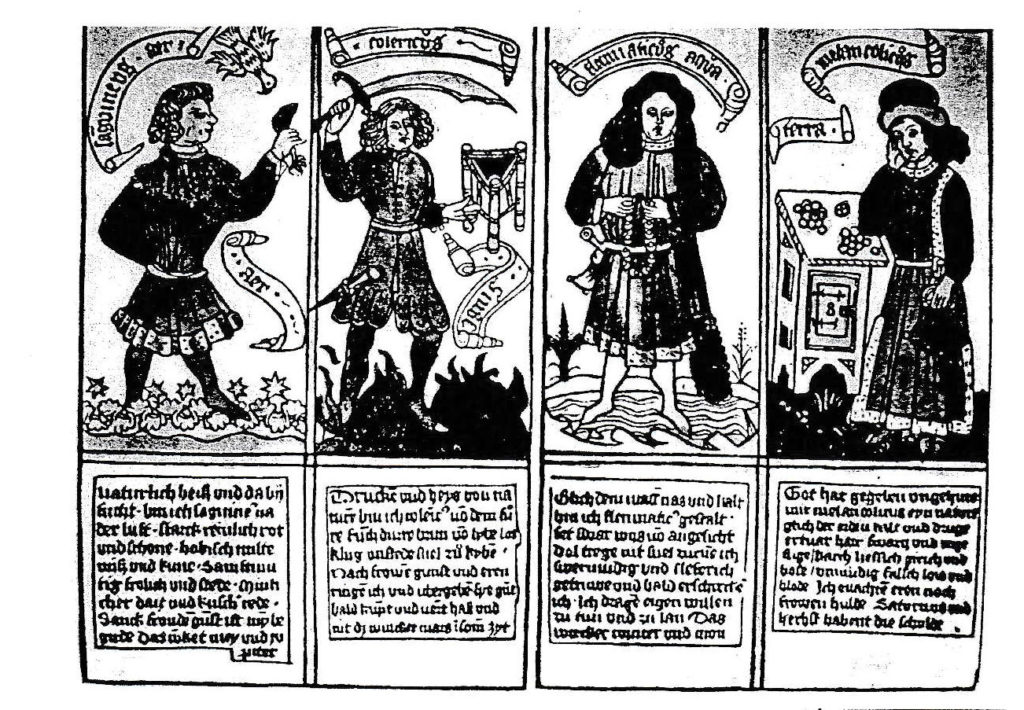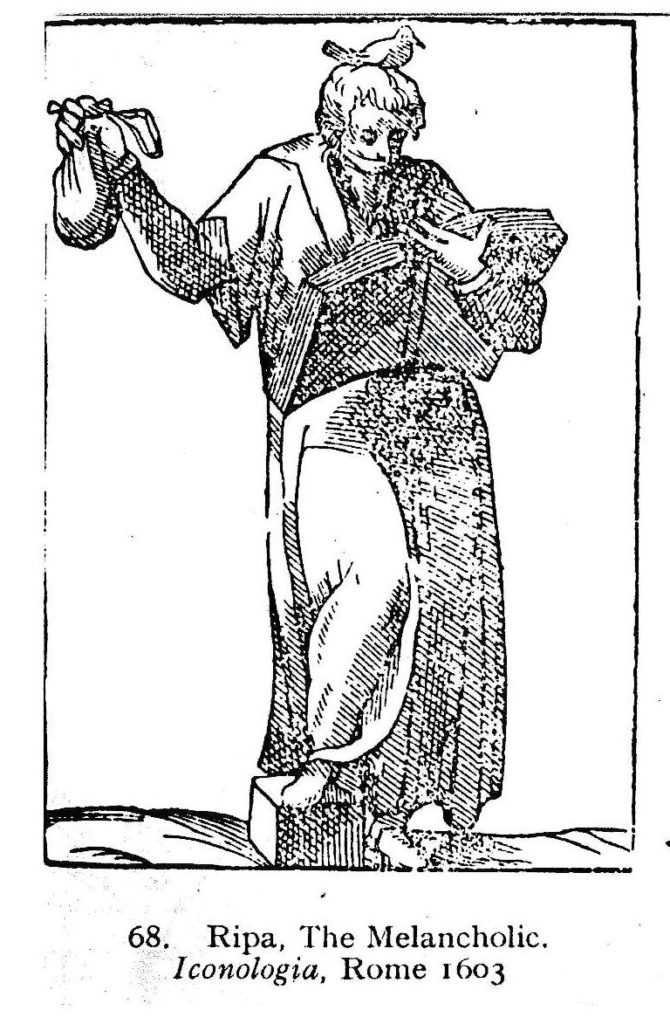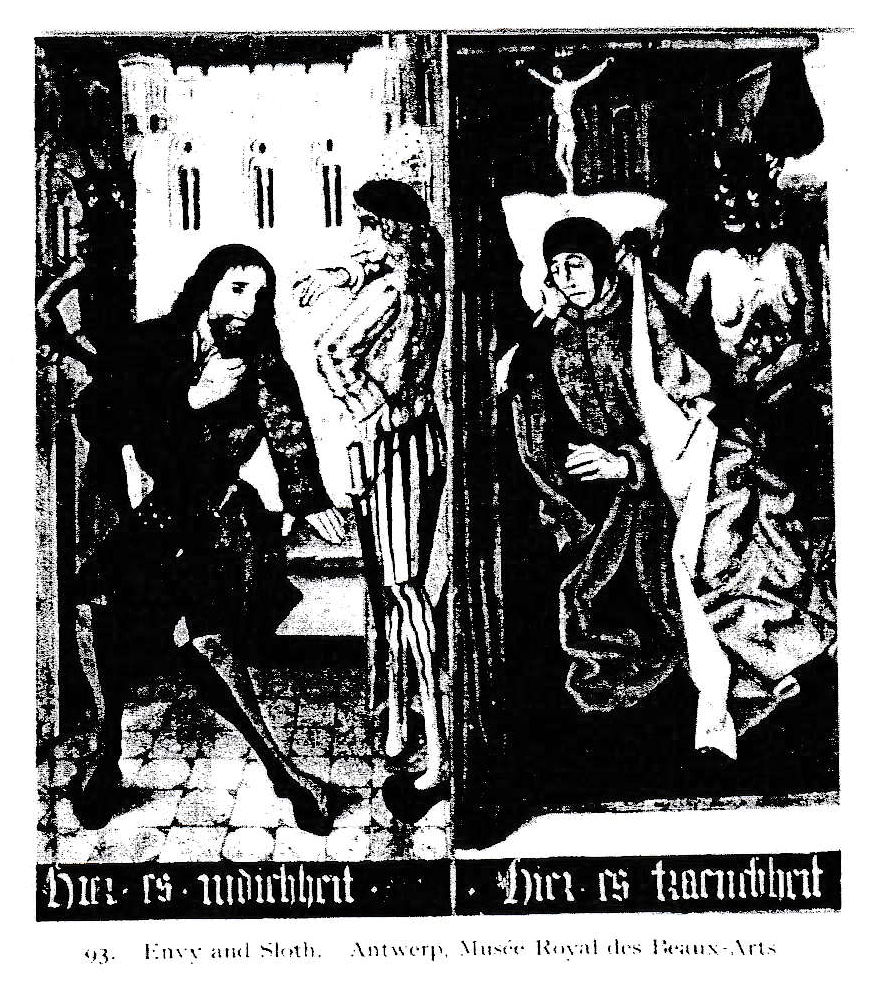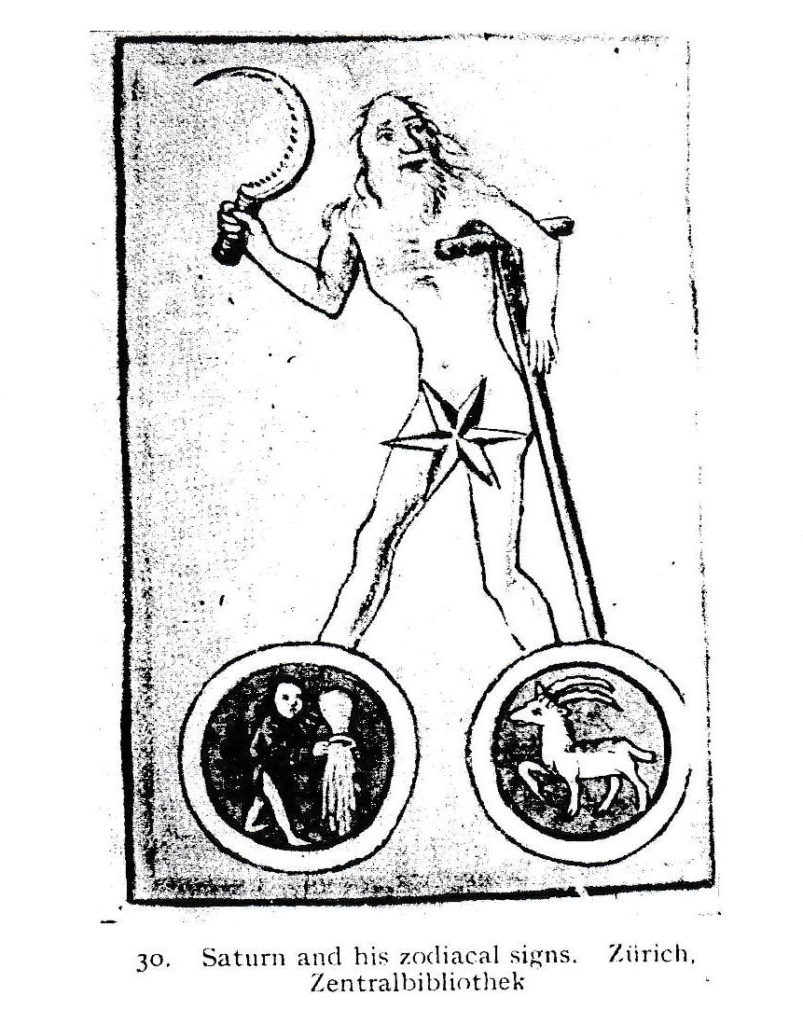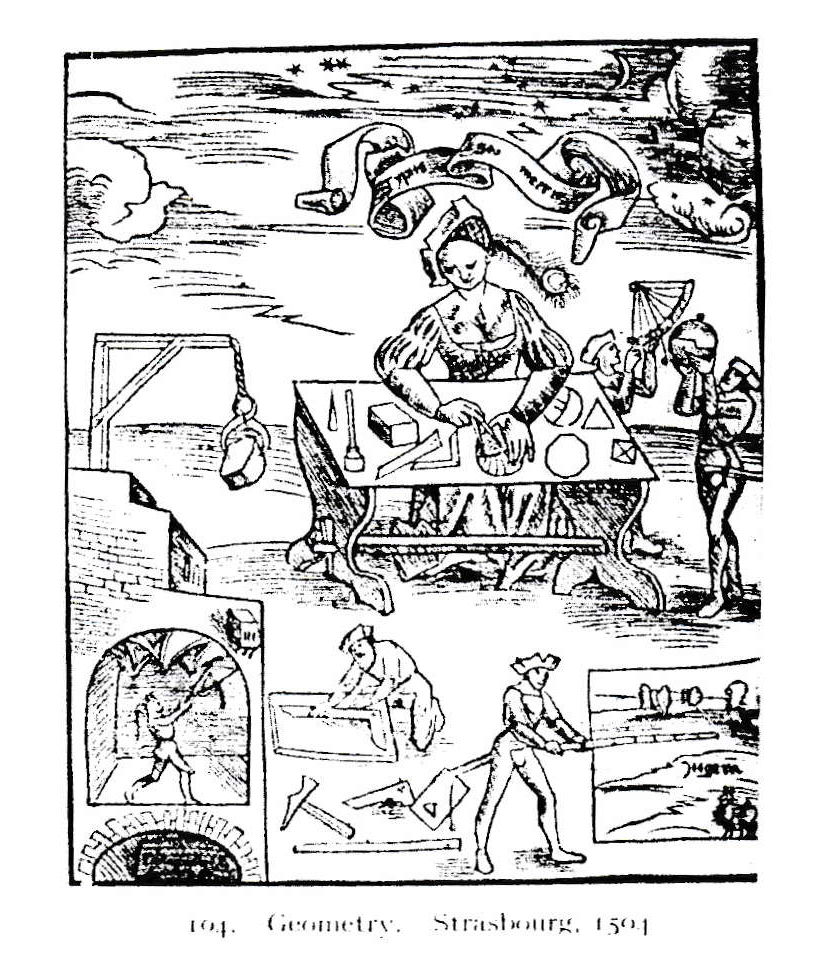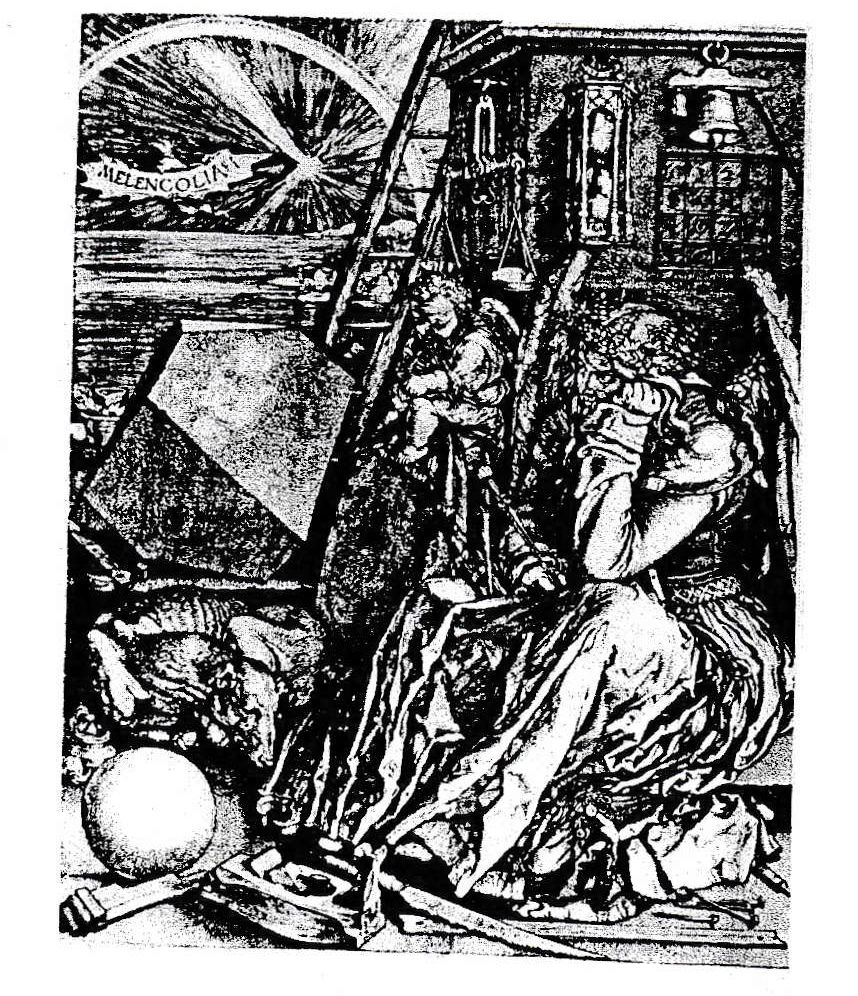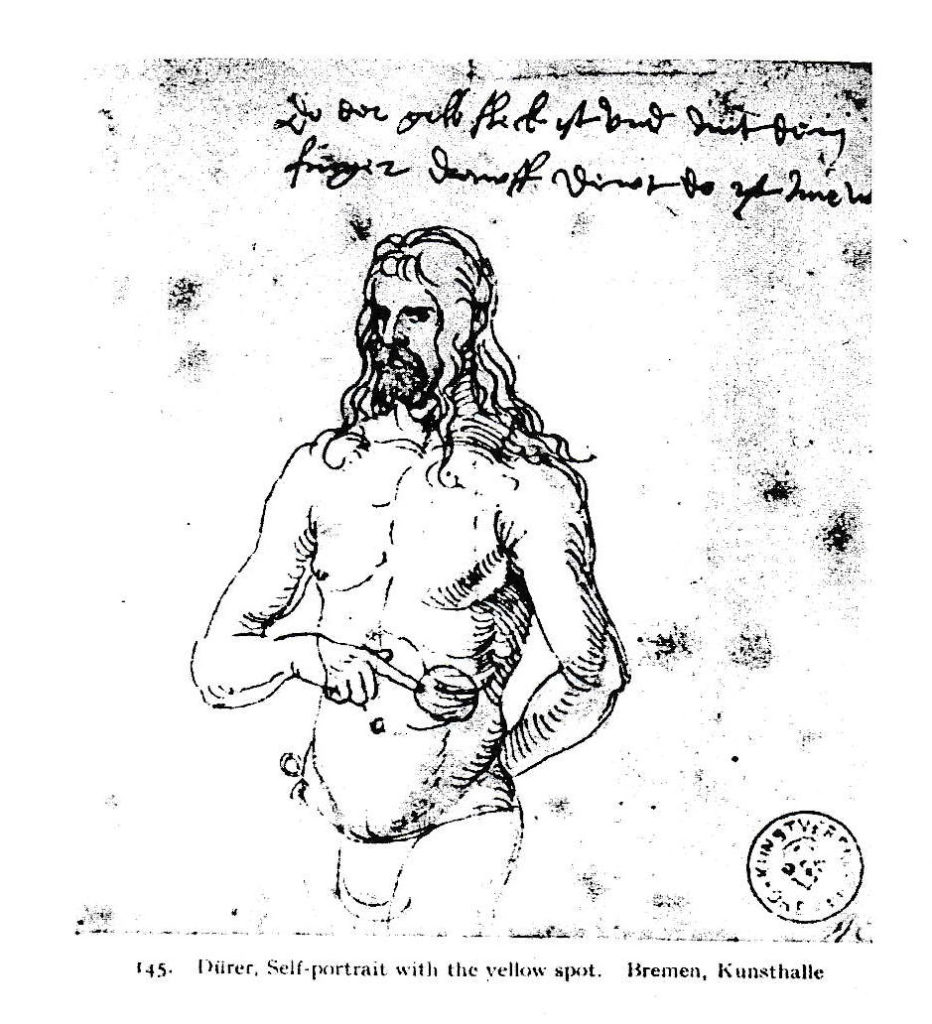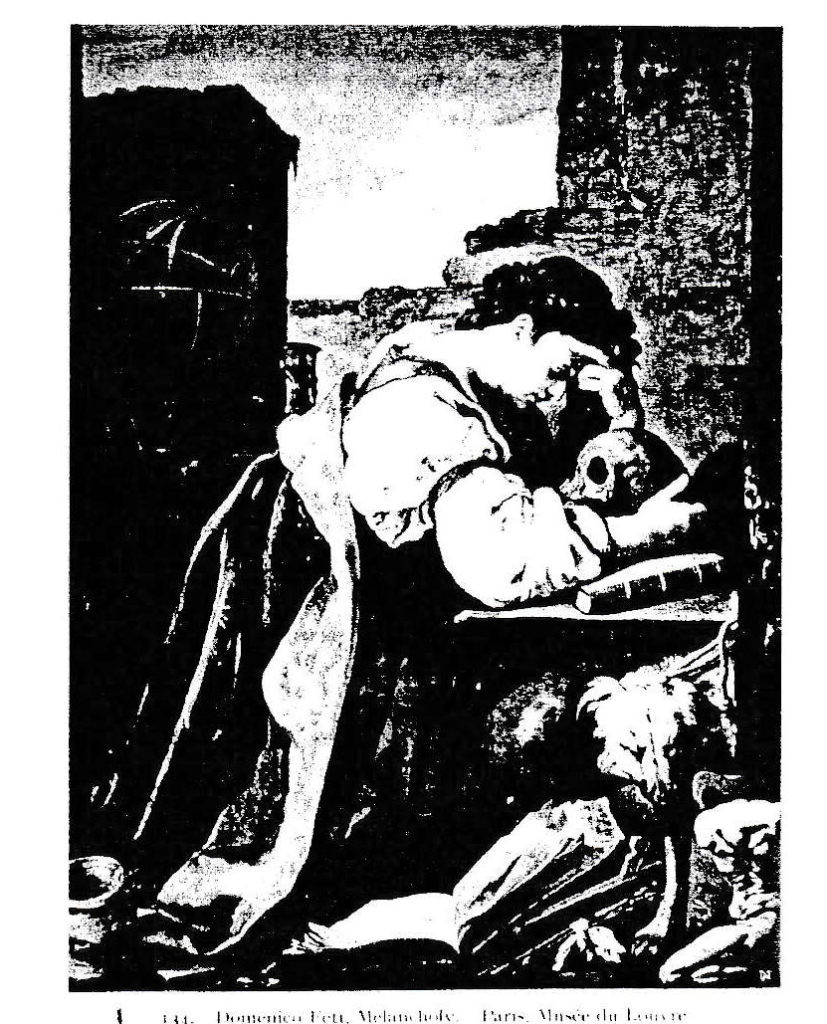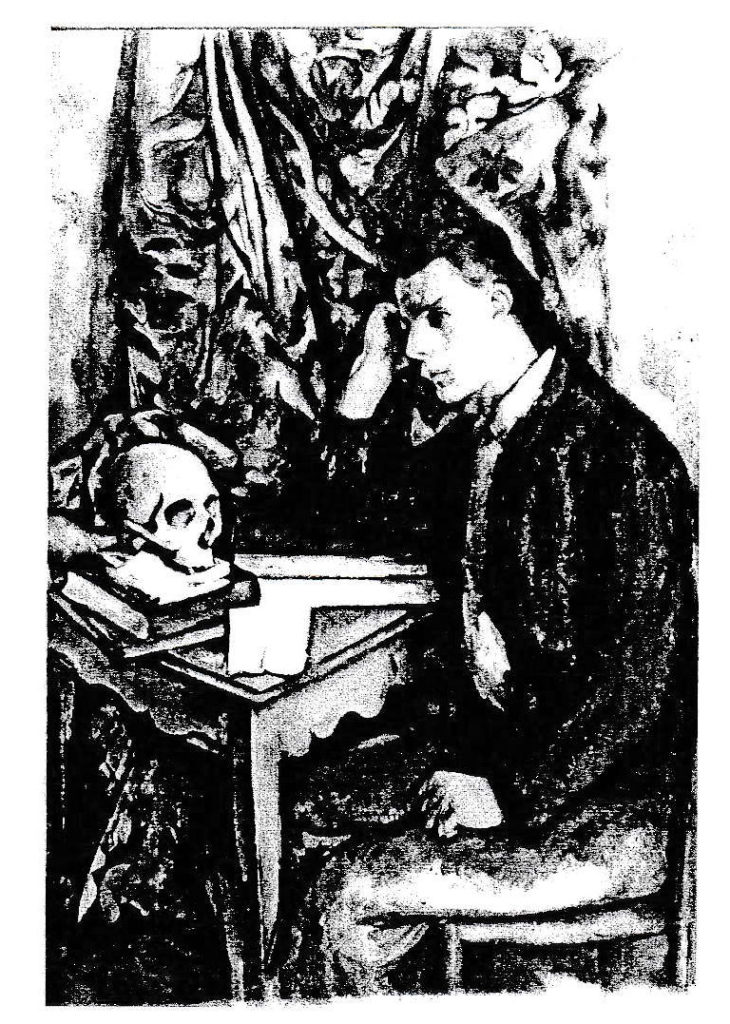A Chinese-Western „Anatomy of Melancholy“ [1]
 Druckerfreundliche Version/ printer-friendly version
Druckerfreundliche Version/ printer-friendly version
Monika Motsch
1. Representations of Melancholy in Western and Chinese Art
In Western medieval art, the melancholic is often represented as one of the „Four Temperaments“: In a picture of the 15th century we can see first the hopeful sanguine, next the violent choleric, then the fat phlegmatic and last the melancholic, with one hand gloomily on his cheek and with the other on his purse.[2](Fig. 1) How bad his character is we can judge from the verse written underneath:
God has given me unduly
In my nature melancholy
Like the earth both cold and dry
Black of skin with gait awry
Hostile, mean, ambitious, sly
Sullen, crafty, false and shy
No love for fame or woman have I
In Saturn and autumn the fault does lie.[3]
In other representations, melancholy makes people bookworms and misers. (Fig. 2)[4] Or it makes them envious and lazy. It is actually the devil, who will get people straight into hell. (Fig. 3)[5]
In the Christian Middle Ages melancholy was regarded as a deadly sin. Christian saints claimed that when Adam fell from grace by eating the apple, the sin of „melancholy curdled in his blood“. [6] In medieval cosmology, melancholy was an evil force pervading the whole universe.
But in the Renaissance, melancholy was suddenly regarded as a mark of genius. The German artist Albrecht Dürer (1471-1528) linked it not only to the ill-fated star Saturn (Fig. 4)[7], but also to the artistic and ordering faculties of „geometry“ (Fig. 5)[8], which he regarded as essential to his art. His famous engraving „Melencolia I“ is full of tense contrasts (Fig. 6)[9]: The rhombus, which blocks the view is set against the sphere; signs of death, like the hour-glass, contrast with the child. Most extraordinary is the figure of the woman: She is heavy, but has wings; one of her hands rests passively, but the other is clenched into a fist; contrary to expectations, her eyes are concentrated and wide awake. Most scholars agree that the engraving is a self-image of the artist who presented himself as suffering from black gall, which is melancholy. (Fig. 7)[10]
In the seventeenth century melancholy became rather fashionable for elegant ladies and gentlemen, especially when they were in love. The painting by the Italian Domenico Feti (1589-1623) is more seductive than desperate. (Fig. 8)[11] Here, the symbols of death, art and geometry become attributes enhancing the erotic attractions of a beautiful woman. In a beautiful painting by Paul Cézanne (1839-1906), melancholy is portrayed as a pensive young man, again with one hand on his cheek and with a skull before him. (Fig. 9)[12]
In Western literature, one of the most comprehensive treatments of pre-modern melancholy is Robert Burton’s Anatomy , which uses materials from the whole Western tradition. The title-page shows different melancholic types (Fig. 10)[13]: The raving madman, the elegant lover, the hypochondriac. But there is also a remedy provided in the person of the author: Just as the Greek doctor Democritus cut up animals to get at the seat of the black gall, Burton wants to anatomize his own melancholy in order to comfort not only himself but also his readers.
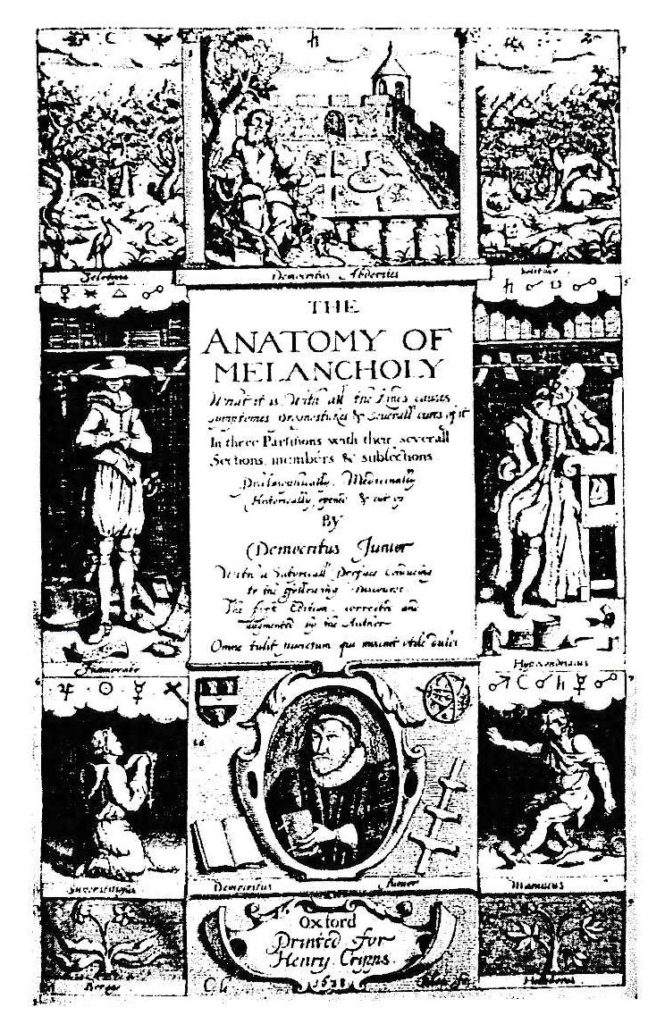
It is certainly a pity that Burton did not know Chinese in order to contrast, confirm or complement the Western views.
One of the first presentations of Chinese melancholy is the famous calligraphy „Lantingxu“ 兰亭序 („Gathering at the Orchid Pavillon“) by Wang Xizhi 王羲之 (321-379). (Fig. 11)[14]Wang describes a spring excursion with poets and artists, who let their wine-cups float on a small stream, talking and making poems. Suddenly the happy atmospere gives way to a melancholy mood, and the friends reflect on the transitoriness of spring and of all of life’s joys. (Fig. 12)[15]
Contrasting Chinese and Western traditions in this aerial view, the difference could not be more striking. Yet taking a closer look, we can discover a great many similarities. These include basic concepts of life as well as literary images and aesthetic judgments.
2. The Theory of Melancholy: The Two Traditions
Chinese melancholy is first mentioned in the Li Ji 礼记 (chap. “Liyun“ 礼运) as one of the „Seven Emotions“ (qiqing 七情)[16]. Like its counterpart in Western cosmology, it is correlated with autumn, cold, death, war, as well as the „White Tiger“.[17]But the concept of the „Seven Emotions“ never changed or developed for over two thousand years.
One important reason is the fact that the expression of personal grief had a dangerous political dimension. Already in the „Great Preface“ of the Shijing 诗经 it is said:
治世之音安以乐,乱世之音苑以怒,亡国之音哀以思
In times of peace the songs are joyful, in times of chaos angry and at the end of a dynasty melancholy.
When the Tang-poet Meng Jiao 孟郊 (751-814) wrote:
不才明主弃,多病故人疏
Discarded by my emperor
Sick and without friends
legend goes that the enraged emperor banished him immediately. Under authoritarian governments, in China as well as in the West, only songs of praise are allowed.
On the other hand, there is a Chinese counter-tradition hidden in histories, philosophies and especially in literature. Here we can find many penetrating and illuminating insights.
First of all, most antique Chinese writers agree, that life is full of suffering and that happy times are few. An early source is Zhuang Zi (chap. “Dao Zhi” 盗跖):
人上寿百岁,中寿八十,下寿六十。除病瘦死丧忧患,其中开口而笑者,一月之中,不过四五日而已矣!
Those who are blessed with longevity will live to sixty, eighty, or a hundred at most. From this you have to subtract the days when you are sick, in mourning or melancholy. So in a month there are only four or five days, when you really laugh loudly![18]
Since life is a rather miserable affair, Chinese writers have reflected about methods of relief. Already in the Lun Yu (chap. “Yang huo” 阳货) and the “Great Preface” of the Shijing, literature was discovered to be a potent medicine.[19]
In the Han Dynasty, the historian Sima Qian 司马迁 (ca 145-85 B.C.) was the first who claimed that beginning from the Book of Songs all great works had been written in prison or in banishment, out of anger and “pent up melancholy” (yujie 郁结).
In the Tang-Dynasty this view became an aesthetic dogma. Han Yu 韩愈 (768-824) ranked that poetry highest which had been written by qiaocui zhi shi 憔悴之士, “melancholy, emaciated writers” (“Jing Tan Chang he shi xu” 荆潭唱和诗序):
夫和平之音淡薄,而愁思之声要妙,欢愉之辞难工,而穷苦之言易好也。
Harmony is insipid, songs of melancholy are magic. Happiness is difficult to describe well, yet pain and poverty are easy.[20]
Naturally many people wanted to become famous poets even though they were not exactly “emaciated” from suffering. There appeared an enormous amount of tearful poems, which were criticized by Li Zhi 李贽 (1527-1602) as bu bing er shen 不病而呻, „groaning without sickness“.
In China as well as in the West, melancholy was discovered to be a creative stimulus. Yet the historical development was very different. In the West, the concept was first mentioned in a Greek treatise attributed to Aristotle. But in the Middle Ages the idea was obscured and forgotten. Only in the Renaissance it was rediscovered and really developed.[21] In China, this occurred about a thousand years earlier. Yet just because the tradition lasted so long, it became a stereotype, which was discredited and neglected.
3. Personifications and images
Probably the first personification of melancholy can be found in the essay „Shi chou wen“ 释愁文, „Dispelling Melancholy“ by Cao Zhi 曹植 (192-232). Being imprisoned by his brother Cao Pi 曹坯 (187-226) and having lost all hope to become his father’s successor he writes:
Full of melancholy, I walk groaning by the roadside, shrivelled and emaciated, my sorrowful heart like that of a drunkard. Mr. Darkness came to see me and asked: How could you become so sick? I said: My sickness is melancholy. He asked: What creature is this to make you so sick?
The monster melancholy, I answered, is undefinable and invis-ible, floating like a ghost in the air. He comes uninvited and cannot be pushed away. You cannot reach his boundaries, but he can also be smaller than a handful. In lonely nights or in crowds of people, he comes and goes unexpectedly and throws my mind over … I have trouble swallowing my food, worries and resentments make my head ache…[22]
Still more powerful are the images of the fragment „Choufu „愁赋, „Song of Melancholy“ by Yu Xin 庾信 (513-581), which was written during his exile in the North. In this poem, Melancholy is represented as a mighty devil. Having magic powers, he is everywhere, expanding into the universe or rolling up into the small place of a human heart. Nevertheless the speaker of the poem engages in a fierce fight against his inner demon:
攻许愁城终不破,荡许愁门终不开,何物煮愁能得熟,何物烧愁能得然,闭门欲驱愁,愁终不肯去,深藏欲避愁,愁已知人处,谁知一寸心,乃有万斛愁?
I ram against the walls of Melancholy-City
It doesn‘t fall
Bang at the gates
They do not open
What can boil him pulpy? What can burn him out?
I shut my door to drive him away
He will not budge
I hide myself from him
But he always seeks me out …
How can an inch-wide heart
Hold thousand gallons of grief?[23]
In later adaptations Melancholy appears less frightening, the wild combat gives way to a more playful mood. Xin Qiji 辛弃疾 (1140-1207) writes („Hemingting du yin“ 鹤鸣亭独饮):
小亭独酌兴悠哉,忽有清愁到酒杯,四面青山围欲合,不知愁自那边来!
Drinking alone at the pavillon
My spirits run high
Suddenly melancholy jumps into my wine-pot
Yet all around only green mountain-walls
How could he find the way?
Gong Zizhen 龚自珍 (1782-1841) goes one step further in a poem, which, by an original twist, ends with a declaration of love („Fu youhuan“ 赋忧患):
故物人寰少,犹蒙忧患俱,春深恒作伴,宵梦亦先驱,不逐年华改,难同逝水徂,多情谁似汝,未忍托禳巫.
Lonely and without friends
With melancholy my sole companion
He keeps me company in spring
Visits my dreams at night
Does not change with the changing seasons
Flows not away with the flowing water
Who could be so loving as You?
I shall certainly refuse
To call witches to drive you out.[24]
It is sometimes held that Chinese literature has no personifications.[25]As a matter of fact, Melancholy was personified much earlier than in the West.[26]The image of the unsurmountable wall blocking the view is an archetype, which also appears in Dürer’s engraving. Kierkegaard uses a similar metaphor when he says: „My melancholy is my fortress“.
In Chinese literature, these personifications and images marked an important shift of values, an internalization. Melancholy was no longer regarded as a cosmic, outside force, but as a personal demon, that originated from within (fan qiu zhu ji 反求诸己). This meant a heightened self-awareness and a great leap forward in the exploration of personal emotions.
4. The Discovery of contradictory feelings
The internalization of melancholy was accompanied by psychological and literary discoveries. Most important was the insight that joy and grief were closely related and that extreme joy would provoke despair.[27]
Zhang Heng 张衡 (78-139) described a great banquet in this way ( Xijingfu 西京赋予):
於是众变极,心酲醉,盘乐极,怅怀萃
Then all variations (of joy) are explored
My heart is drunk
The music reaches its climax
I am in despair
Du Fu 杜甫 (712-770) describes enthusiastically a sword-dance by a famous dancer, only to say at the end (“Guan Gongsun daniang dizi wu jianqi ge” 观公孙大娘弟子舞剑器歌):
玳筵急管曲复终,乐极哀来月东出。
The music plays wildly
The melody ends
When joy is greatest
Sadness arrives
The rising moon in the east[28]
The sudden fall from pleasure to pain, the awareness of the transitoriness of all joys, can be traced all through Chinese literature, including such well-known works as Su Shis 苏轼 (1037-1101) “Chibifu” 赤壁赋 (The Red Wall) or the Hongloumeng.
The earliest psychological explanation is given by Wang Xizhi in the “Lantingxu”:
(On our spring excursion) we let our eyes wander and were free, all our senses were awake and we were happy! … But at the climax we got weary, our feelings changed and we got melancholy. What we enjoyed had become, in the twinkling of an eye, traces of the past.[29]
The rapid emotional change creates an interesting mixture of feelings. This led to an important aesthetic shift. Henceforward Chinese critics especially valued complexities like “the joy in grief, the grief in joy“ (忧中有乐,乐中有忧).[30]
In the West, the description of mixed, contradictory feelings started with Milton’s „Il Penseroso“. Western critics described it as a voluptous bitter-sweet feeling, „the mournful joy“ or „the sad luxury of woe“.[31]
Though the aesthetic concept is similar in East and West, the feelings evoked are different. Because of the highly condensed language of traditional Chinese poetry, the clash seems more sudden and dramatic. It strikes the reader more like a shock, than a bitter-sweet symphony of woe.
5. Melancholy as a Fashion
An example, which has many Western parallels, is shangchun 伤春, “spring melancholy”.[32]
In traditional China, autumn was reserved for the lament of old men, while in spring young girls would become sad because they longed for a lover. The earliest source is the Book of Song (“Qiyue” 七月)
春日迟迟,采繁祁祁,女心伤悲,殆及公子同归。
In spring the days are getting longer
The girl is busy plucking mulberry leaves
She gets sad and melancholy
And is afraid
She won’t marry
Zheng Xuan’s commentary describes the confused feelings of the girl very well:
In spring, the girl feels the Yang spirit and longs for a man ….Things change, therefore she is sad. Being sad, she begins to think of a man and wants to marry.
Since the Six Dynasties, this became a favourite theme of court poetry. Yet the court ladies wore beautiful transparent silks and ornaments, which made it difficult for them to engage in plucking mulberries. Therefore in the Tang-Dynasty, the mulberries were changed into flowers. At the same time, the girls, having much leisure at their hands, were getting more and more melancholy and enticing. Finally, in the Hongloumeng, even plucking flowers was considered as something vulgar, as can be seen in the case of Lin Daiyu.
Chinese lovers, while suffering from spring-fever got awfully thin, which became rather fashionable.[33] Even so fat and happy a pig as Zhu Bajie in the opera Xiyouji 西游记 by Yang Jingxian 杨景贤 is made to say (Act 13):
I, the son of Master Pig, am normally white and clean, but now, out of longing for a woman, I am black and emaciated, thinking that Sima Xiangru in the Han-Dynasty and Cui Hu in the Tang all have suffered from this sickness, as it is recorded in the Histories.
This was usually accompanied by “belt-tightening”, which suggests how much their body was wasting away. An example is the Tang-Dynasty poem „The Devil of Melancholy“ (“Chou gui” 愁鬼):
特解宽衣带,偏能损面皮.
The devil is a specialist in making my belt loose
And in making me ugly.
Another important clue signifying “spring-melancholy” is the “loosening bracelet”. Wang Shifu 王实甫 (13 th cent.), Xixiangji 西厢记, Act 4,3:
听得道一声去也,松了金钏。
When I heard that he had gone
my golden bracelet became loose.
But in the novel Ernü yingxiongzhuan 儿女英雄传 (chap. 34, 40) the author is going a bit far when a girl says, that as soon as she knew her lover was leaving, „her bracelet clashed to the ground“ and “her waist slimmed as much as four fingers“. The theme had really outlived itself. In the twentieth century, it appears only in ironical contexts.[34]
In China and in the West, the symptoms as well as the cure for this disease are the same. In the Xixiangji 西厢记 Cui Yingying 崔莺莺 recovers miraculously from her disease, which no doctor could cure, after spending a night with her lover. Robert Burton, too, though a bachelor as well as a clergyman, says frankly:
The last refuge and surest remedy, to be put in practice in the utmost place, when no other means will take effect, is to let them go together, and enjoy one another … „And let them both be joined in a bed”…[35]
6. Healing Melancholy: Silk-knot and Anatomy
In China, experts like Du Fu recommend wine, music, philosophy and travelling, which can be confirmed by Western authorities. There are also some differences: Burton advises a complicated diet, while the Chinese only insist on eating something, which shows the superiority of the Chinese tradition. On the other hand, the Chinese only play chess or practise calligraphy, while Burton, as an Englishman, also recommends sports, especially kicking a ball. Yet the basic cure is the same: Both Chinese and Western sources agree that the best way is to drive one poison out with another (yi du gong du 以毒攻毒): Melancholy can only be cured by melancholy.
In China, this is best illustrated by the double-edged metaphor of the silk-knot.[36] The silk-knot is a vivid image of melancholy, which is like a thread going through all Chinese literature of grief.
After China’s first poet Qu Yuan 屈原 (ca. 340-278 B.C.) had been banished from court, his feelings were in a turmoil. He wept, wanted to leave his country and the world, but was wavering. In this dilemma he wrote “Ai Ying” 哀郢, “Longing for the city Ying”:
心絓结而不解兮,思蹇产而不释。
My heart is tangled silk
A knot which cannot be untied
The image uses a play on the Chinese sound si, which can mean 丝 “silk”, but also 思 “to think, to grieve”. There are many combinations like qingsi 情丝, „the silk of feelings“ or sixu 思绪, “the silk-knot”, “threads of thought”. Melancholy is described as a moving stream, flowing like a silk-thread. There are many poems and songs that employ this metaphor. Here are a few examples:
A Yuefu of the Six Dynasties (“Huashanji” 华山畿):
腹中如乱丝,愦愦适得去,愁毒已复来.
In my belly a tangled knot
I drive it out wildly
But the melancholy poison
flows back again
Li Shangyin 李商隐 (813-858) („Chun guang„春光):
几时心绪浑无事,得似游丝百尺长。
If one day (the silk of) my feelings were free
It would be a gossamer miles along
Li Houzhu 李后主 (937-978) (“Xiang jian huan” 相见欢):
剪不断,理还乱,是离愁。
I cannot cut it
Cannot unravel it
The grief of separation.[37]
Li Houzhu (“Die lian hua” 蝶恋花):
一寸相思千万缕,人间没个安排处.
An inch of love
A million silky threads
On the whole world
Not room enough
To unravel it.
In Yuan Zhens 元稹 (779-831) „Ying Ying zhuan“ 莺莺传 (The Story of Ying Ying), the image gets a symbolical meaning. After Ying Ying has been left by her lover she sends him a skein of tangled silk (乱丝一絇) and writes: “My melancholy mind is tangled silk … I give you this to express my feelings” (愁绪萦丝,因物达情).
The tangled silk-knot is also an antidote. If it is not too hopelessly knotted, it can be disentangled and made into literature. This meaning can already be found in Qu Yuan (悲回风):
乣思心以为纕兮,编愁苦以为膺。
I search my feelings and make them into a belt
Out of my bitter grief I weave a vest.
Also Li Houzhu in “Chou si“ 抽思:
结微情以陈词
I weave a song out of my invisible feelings
This has been echoed by many Chinese poets, i.e. by Du Fu (“Zhi hou” 至后):
愁极本凭诗遣兴
In greatest grief I always relied on poetry for relief
The idea is still alive in the proverb chang ge dang ku 长歌当哭: “Instead of crying, I make a loud song”.
The metaphor of the silk-knot has no exact equivalent in the West, since it is closely connected with the Chinese script and the Chinese literary tradition. Yet we can set it against Burton’s „Anatomy“. The idea is the same: Burton also wants to find a cure against the disease by making an antidote out of it:
And as that great captain Zisca would have a drum made of his skin when he was dead, because he thought the very noise of it would put his enemies to flight, I doubt not that these following lines, when they shall be recited, or hereafter read, will drive away melancholy (though I be gone) as much as Zisca’s drum could terrify his foes.[38]
In China as in the West, melancholy literature is not only a relief for the author but also for his readers. Many Chinese over the ages have declared that the poems of Du Fu, though sad and desperate, have cheered them up. Du Mu 杜牧 (803-852) wrote:
杜诗韩集愁来读,似倩麻姑痒处搔。
When sorrows approach
I read Du Fu and Han Yu
And feel as if
The beautiful long-nailed Ma Gu
Was scratching my itching point
In the same vein Burton:
I write of melancholy, by being busy to avoid melancholy …. one must needs scratch where it itches.
Why is it that melancholy literature exercises such a happy effect on a gloomy reader? I think the secret lies in the fact that the silk is disentangled and the feelings are anatomized: If they are personified, the monster Melancholy becomes visible so that you can fight against it. If the silk is woven into beautiful images, it becomes possible, for the moment at least, to drive away the monsters and even say with Burton:
All my joys to this are folly,
None so sweet than melancholy.
Bibliography
Burton 1961. Robert Burton, The Anatomy of Melancholy, 3 vols, Everyman’s Library 1961.
Barnes 1993. La joie de vivre. Die nie gesehenen Meisterweke der Barnes Collection, aus dem Amerikanischen von Irene Bisang u.a., München: Kindler 1993.
Cao Zhi 1984. Cao Zhi, 曹植集校注, Beijing: Renmin wenxue 1984.
Klibansky 1964. Raymond Klibansky, Erwin Panofsky, Fritz Saxl, Saturn and Melancholy: Studies in the History of Natural Philosophy, Religion and Art, Cambr.: Nelson 1964.
Ledderose 1979. Lothar Ledderose, Mi Fu and the Classical Tradition of Chinese Calligraphy, Princeton: Princeton University Press 1979.
Needham 1962. Joseph Needham, Science and Civilisation in China, vol II, Cambr.: Cambr. University Press 1962.
Qian Zhongshu 1985. Qian Zhongshu 钱钟书, “Shi keyi yuan” 诗可以怨, in: Qizhuiji 七缀集, Shanghai: Shanghai guji 1985.
Qian Zhongshu 1991. Qian Zhongshu, Guanzhuibian 管锥编, 4 vols, Beijing: Zhonghua shuji (19791, 19802) 19913.
Yu Xin 1985. Yu Zishan ji 庾子山集, 2 vols, Beijing: Zhonghua shuju (19801) 19852.
Illustrations
1. “The Four Temperaments”. Middle of the fifteenth century. Zürich, Zentralbibliothek. Klibansky 1964: No.78.
2. “The Melancholic”. Cesare Ripa, Iconologia. Rome 1603. Klibansky 1964: No. 68.
3. “Envy and Sloth”. Antwerp Master, about 1490-1500. Antwerp, Musée Royal des Beaux-Arts. Klibansky 1964: no.93.
4. “Saturn and his zodiacal signs”. 1470, Zürich, Zentralbibliothek. Klibansky 1964: no. 30.
5. “Geometry”. Gregor Reisch, Margarita philosophica. Strasbourg 1504. Klibansky 1964: no. 104.
6. Albrecht Dürer. “Melencolia I”. Engraving 1517.
7. Dürer. “Self-portrait with the yellow spot. Drawing 1512-4. Bremen, Kunsthalle. Klibansky 1964: no.1.
8. Domenico Feti, “Melancholy”. About 1614. Paris, Musée Louvre. Klibansky 1964: no.134.
9. Paul Cézanne, “Jeune homme à la tete mort” (Junger Mann mit Totenschädel). 1896-98. Öl auf Leinwand. Barnes 1993:151f
10. The Anatomy of Melancholy.Title-page by C. Le Blon to Robert Burton’s book. Oxford 1938. Klibansky 1964: no. 112.
11. Wang Xizhi, “Lantingxu”. Detail of beginning section. Ledderose 1979: no. 26.
12. Wang Xizhi, “Lantingxu”. Detail of last section. Ledderose 1979: no. 25.
[1] For this paper, I have mainly used materials from three works: 1. Qian Zhongshu 1991. Burton 1961. 3. Klibansky 1964.
[2] _“The Four Temperaments”. Middle of the fifteenth century. Zürich, Zentralbibliothek. Klibansky 1964: No.78
[3] Klibansky 1964:117
[4] “The Melancholic”. Cesare Ripa, Iconologia. Rome 1603. Klibansky 1964: No. 68
[5] “Envy and Sloth”. Antwerp Master, about 1490-1500. Antwerp, Musée Royal des Beaux-Arts. Klibansky 1964: no.93
[6] Klibansky 1964: 79
[7] “Saturn and his zodiacal signs”. 1470, Zürich, Zentralbibliothek. Klibansky 1964: no. 30.
[8] “Geometry”. Gregor Reisch, Margarita philosophica. Strasbourg 1504. Klibansky 1964: no. 104.
[9] Albrecht Dürer. “Melencolia I”. Engraving 1517. Klibansky 1964: no.1.
[10] Dürer. “Self-portrait with the yellow spot. Drawing 1512-4. Bremen, Kunsthalle. Klibansky 1964: no. 145.
[11] Domenico Feti, “Melancholy”. About 1614. Paris, Musée Louvre. Klibansky 1964: no.134.
[12] Paul Cézanne, “Jeune homme à la tete mort” (Junger Mann mit Totenschädel). 1896-98. Öl auf Leinwand. Barnes 1993:151f.
[13] The Anatomy of Melancholy.Title-page by C. Le Blon to Robert Burton’s book. Oxford 1938. Klibansky 1964: no. 112.
[14] Wang Xizhi, “Lantingxu”. Detail of beginning section. Ledderose 1979: no. 26.
[15] Wang Xizhi, “Lantingxu”. Detail of last section. Ledderose 1979: no. 25.
[16] The “seven emotions” are joy, anger, grief, fear, love, hate, desire (xi 喜, nu 怒, ai 哀, ju 惧, ai 爱, wu 恶, yu欲 ”˚). See also Baihutong 白虎通 (chap. “Qingxing” 情性) which lists six emotions
[17] Needham 1962:262f.
[18] See Qian Zhongshu 1991:521.
[19] For the next paragraphs I have used materials from Qian Zhongshu 1985:101-116.
[20] In the Ming und Qing Dynasties, scholars found a psychological explanation for this: Pleasure makes people too relaxed. Only pain can make them think creatively. Besides, happiness goes away quickly and leaves no lasting impression. Only grief sinks in deeply and is therefore a better inspiration for artists.
[21] Klibansky 1964:217f
[22] Cao Zhi 1984: 467f.
[23] Yu Xin 1985:1094.
[24] Quotations from Qian Zhongshu 1991: 963.
[25] Cao Zhi’s “Melancholy” is a transference of an earlier personification of poverty by Yang Xiong — 杨雄(53 B.C. – 18) “Zhu pin fu” 逐贫赋. See Qian Zhongshu 1991: 961. For other personifications see ibid. 86, 543f, 1347ff.
[26] In the West Melancholy was personified as “Dame Mérencolye” at the end of the Middle Ages (Klibansky 1964:221).
[27] Qian Zhongshu 1991:884f.
[28] In another poem, Du Fu describes in one line the happiness of eating a beautiful fat fish, in the next his following depression. “Guan dayu ge” 观打鱼歌:
鲂鱼肥美知第一,既饱欢娱亦萧瑟
[29] Qian Zhongshu 1991: 884f.
[30] Su Shi used this expression to praise the poems of Liu Zongyuan 柳宗元(773-819). See Qian Zhongshu 1991:227.
[31] Klibansky 1964:231.
[32] See Qian Zhongshu 1991:130.
[33] Quotations from Qian Zhongshu 553f.
[34] An exception is Zhang Ailing 张爱玲. In the novel „Jinsuoji“ 金锁记 the main figure Qiqiao, as an old woman, looks back on her life; suddenly she notices that her bracelet, which fitted in her youth, can be brought up to her armpit. This is realistic enough. Yet at the same time it carries associations of the traditional „spring melancholy“ in a new and interesting metamorphosis.
[35] Burton 1961: 228f.
[36] Qian Zhongshu 1991: 615-18
[37] Also in Act 33 of the „Xiao Xiyouji“ 小西游记there appears an old lady who says that she has a magic „silk of love“ 情丝, which can bind people together.
[38] Burton 1961:38.
